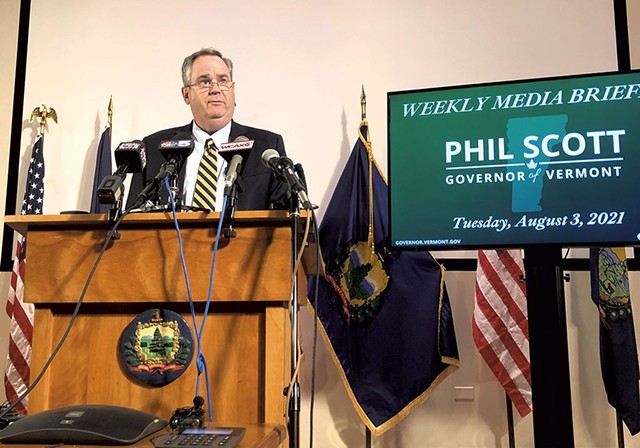
- Sarah Cronin
Amy Wood stepped to the microphone at the Franklin Northeast Supervisory Union school board meeting last week and slammed officials' plans to require her kids to wear masks when they start school.
"We're here today to say, 'No more. We've had enough!'" the Richford resident said, wagging a finger toward board members. "We pay taxes. We pay salaries. You work for us, not the other way around!"
Board members lack the authority to impose a mask mandate absent a state of emergency, she claimed. The idea that school staff would enforce a policy she considered harmful to her children's social and emotional health made her "sick to my stomach."
The recent spike in COVID-19 infections, just as 79,000 Vermont K-12 students are preparing to go back to the classroom, has thrust local school boards and superintendents into the center of a polarizing public health debate over masks in schools.
Without a statewide mask mandate, local leaders have been scrambling to draft their own back-to-school safety protocols, with what they complain is limited time and scant guidance from state officials. Add in a healthy dose of public fear, pandemic fatigue and confusion, and school officials say they're facing some of the most challenging decisions in memory.
"In some communities, there is strong pushback on requiring masks in schools," said Sue Ceglowski, executive director of the Vermont School Boards Association, "to the point where ... it has become uncivil and intimidating to local school officials."
So far, Vermont has avoided some of the fierce, highly partisan battles playing out over the issue in places such as Texas, where the state's Republican governor issued a contested executive order banning mask mandates in schools.
Nevertheless, tensions are high.
At the Franklin Northeast meeting, one resident accused school board members of being "either cowards or ... ignorant." Board chair Mary Niles urged frustrated residents to be respectful, but several repeatedly disrupted the meeting, which included a presentation by a pediatrician, Dr. Rebecca Bell.
An exasperated Niles briefly suspended the meeting as maskless residents shouted questions at the masked board aimed at the legitimacy of Bell's testimony. "Why we are dismissing her level of expertise is beyond me," Niles said.
Marlene Hambleton, meanwhile, praised board members for endorsing superintendent Lynn Cota's plan to require all students, teachers and visitors to wear masks when school starts.
"I personally would not send my preschooler to school without there being a mask mandate for everybody," Hambleton said. "Thank you for doing what I consider to be the right thing."
After Hambleton spoke, others in the audience heckled her.
A similar erosion of public discourse has taken place across the state, including in Washington County, said Brigid Nease, superintendent of the Harwood Unified Union School District. She has received voicemails from people enraged by her decision to require masks for all students again this year, she said.
Others have endured more disturbing feedback.
"One of my superintendent colleagues has received a death threat," Nease wrote in a letter to parents outlining the district reopening plan. "Some principals are receiving letters from groups threatening to storm the schools on the first day."
She declined to identify where such threats were made, saying it was up to those officials to come forward if they chose. Fellow superintendents recommended that the officials contact local law enforcement, Nease said.
She said she is making the threats public to discourage residents from taking out their frustrations on school leaders. In her view, officials are just doing their best to keep children safe. Her district is also requiring all staff to be vaccinated or undergo weekly testing.
"The pandemic has exhausted people," Nease said. "I think people are very confused."
Several factors appear to be contributing to the muddle, including conflicting guidance from state and national sources, and the overlapping state and local authority to manage public schools.
When Gov. Phil Scott lifted Vermont's state of emergency on June 14, the mandates that accompanied it went away, too. This included rules about wearing masks inside buildings, social distancing and limits on the size of public gatherings.
Scott stressed that wearing masks was a "personal choice" people needed to make based on their own risk assessment.

- File: Anne Wallace Allen
- Education Secretary Dan French
On August 4, with case counts on the rise, the state issued a two-page memo explaining that it appeared another state of emergency "will not be justified this year." That compares to 40 pages of guidance issued at the start of last school year. The recent document, signed by Education Secretary Dan French and Health Commissioner Mark Levine, explained that instead of issuing mandates, the state would create nonbinding "advisory memos." Unlike last year, hybrid learning is not an option, and students are expected to return to the classroom five days a week.
The document advised districts to require masks for all children under 12, a group that is not yet eligible to be vaccinated. For those 12 and older, masks should be required for the first 10 instructional days of school to give districts time to gather vaccination data. If, after this period, the districts conclude that 80 percent of the eligible students are fully vaccinated, then mask wearing should be optional. Masks would still be required on buses, per federal rules.
But the memo raised as many questions as it answered, including ones about an apparent conflict with guidelines from the federal Centers for Disease Control and Prevention. The CDC continues to recommend universal indoor masking for all students, staff and visitors to K-12 schools, regardless of vaccination status.
French followed up by clarifying, in an August 18 memo, that school districts have broad authority in statute to "take any action that is required for the sound administration of the school district." School districts "owe students a duty of ordinary care to prevent students from being exposed to unreasonable risk, from which it is foreseeable that injury is likely to occur," he wrote.
Therefore, French stressed, school districts have the power to require masks at schools and may even bar students from attending if they refuse to comply. He likened it to requiring proof of residency or childhood immunizations.
The mixed messages — Scott stressing that mask wearing is a personal choice while many school boards move to make it mandatory — appear to be at the heart of much of the confusion around the issue. He said on Tuesday he still believes mask wearing is a personal choice, but that in school settings students should be required to wear them, as outlined in state guidelines.
Dozens of parents turned out at the Missisquoi Valley School District board meeting last week to protest its mask mandate, with residents vowing to return until the decision was rescinded.
Highgate resident Kim Delorme's voice cracked as she recounted her daughter's experience in kindergarten wearing a mask, the communication challenges it created and Delorme's feeling of failing as a parent. She begged the board to reconsider.
"Why mandate?" she asked. "Leave it up to the parents and the children to choose what is right for them."
In Canaan, in the northeast corner of the state, residents last week cited the lack of a state of emergency to question whether the school board even had the power to require masks, according to board chair Dan Wade.
The board voted 5-0 to reject superintendent Karen Conroy's recommendation to follow state reopening guidance. Explaining why, Wade cited the town's size of just over 900 people, geographic isolation and low infection rate.
"I think it'll be OK," he told Seven Days. "We're a small school."
As of last week, surrounding Essex County did have the lowest number of new infections in the state in the previous 14 days — just six. All told, it has recorded 316 positive cases since the pandemic began and no deaths. That's compared to 8,582 infections and 109 deaths in Chittenden County.
Because of rural Essex County's small population, however, the rate per 10,000 people is the fourth highest in the state, at 505.
And to date, at least 6,241 children statewide ages 19 or under have tested positive for COVID-19. About 4,071 of those were between 10 and 19, while 2,170 were 9 or younger.
None of the 270 Vermonters who have died of COVID-19 were children. The youngest fatalities were three people in their thirties, according to Department of Health data. When children contract COVID-19, they typically experience less severe symptoms than older adults — usually a runny nose, cough, headache and fatigue — and recover more quickly, an average of five days compared to eight for adults, according to the state.
Superintendent Conroy said she was surprised by the Canaan board's decision. But she noted that the district draws students from New Hampshire, and the school district there does not require masks, which may have played a role in the decision.
"I think it's mask fatigue. It's not an 'I don't want to follow the rules' thing," she said. "People are tired. They're looking for a return to normalcy."
Kate Larose said she thinks the board made its decision partly because, due to teleconferencing problems, the majority of meeting participants were parents who attended in person in a "small space without windows with people yelling."
Her 8-year-old son is immunocompromised, and the lack of empathy for his vulnerabilities was striking to her, she said. "I've gotten comments like, 'Don't ask me to set my kid on fire to keep yours warm,'" Larose said.
Canaan isn't alone in its mask stance. The Windham Southwest Supervisory Union says masks are optional. It's not clear how many districts have rejected state guidance — either by adopting rules that are more or less restrictive. Agency of Education officials said they expect that most will follow the guidance.
Gov. Scott finds it "unfortunate" that Canaan chose not to follow the "prudent approach" in the guidelines, a spokesperson, Rebecca Kelley, said in an email.
"Our education system does allow for local control, and without a state of emergency — which is not warranted at this time — we know some schools may make different choices, but we expect most will see the wisdom in our recommendations," she wrote.
Lawmakers jumped into the fray on Tuesday, with House Speaker Jill Krowinski (D-Burlington) and Sen. President Pro Tempore Becca Balint (D-Windham) both issuing statements pressuring Scott to do more. "Parents and teachers are very concerned right now, and this school-by-school and town-by-town strategy isn't helping," Krowinski said. Scott dismissed their critique as "playing politics."
Anne Sosin, a rural health researcher and policy fellow at Dartmouth College's Nelson A. Rockefeller Center, said the current guidance from the state is "really, really muddled."
State leaders are rightly proud of Vermont's nation-leading 85 percent vaccination rate, she said. But with the evidence that breakthrough cases are rising, the state should broaden its approach and get off its high horse, she said.
The vaccination rate in Essex County is 60 percent — 25 percentage points below the state average, and Vermont's lowest, Sosin noted. Allowing kids to go back to school unmasked in a community with an under-vaccinated population and a more contagious variant is reckless, not just on the part of the school board but also the state leaders who left the decision up to them.
"The administration is doubling down on a success narrative when we need to be doubling down on protecting our unvaccinated kids as they head back to school," Sosin said.














Comments
Comments are closed.
From 2014-2020, Seven Days allowed readers to comment on all stories posted on our website. While we've appreciated the suggestions and insights, right now Seven Days is prioritizing our core mission — producing high-quality, responsible local journalism — over moderating online debates between readers.
To criticize, correct or praise our reporting, please send us a letter to the editor or send us a tip. We’ll check it out and report the results.
Online comments may return when we have better tech tools for managing them. Thanks for reading.